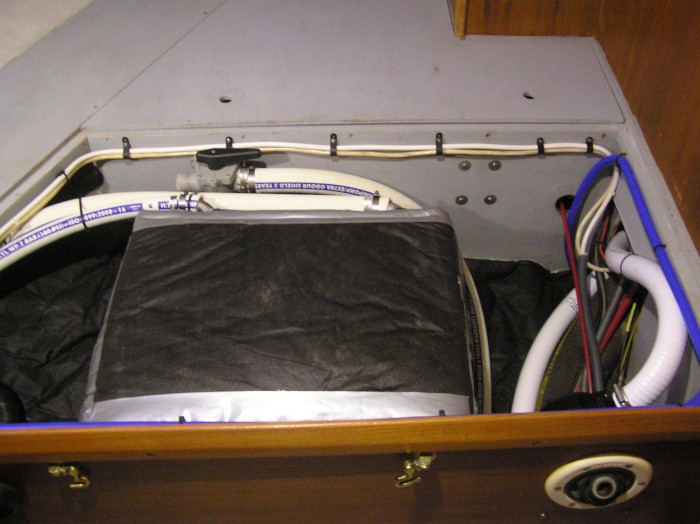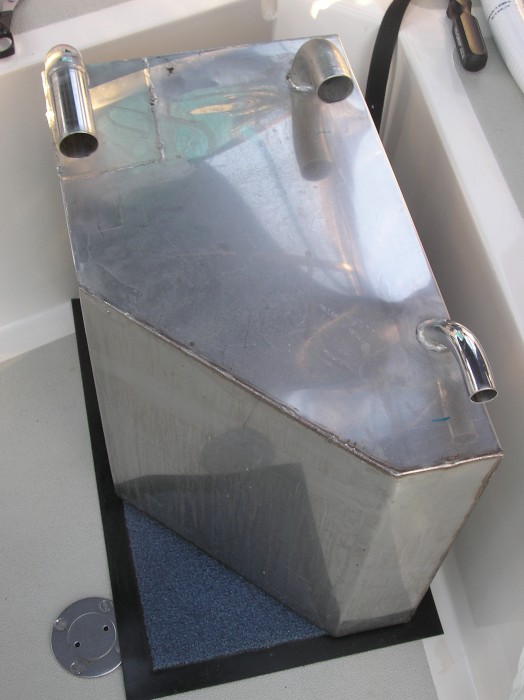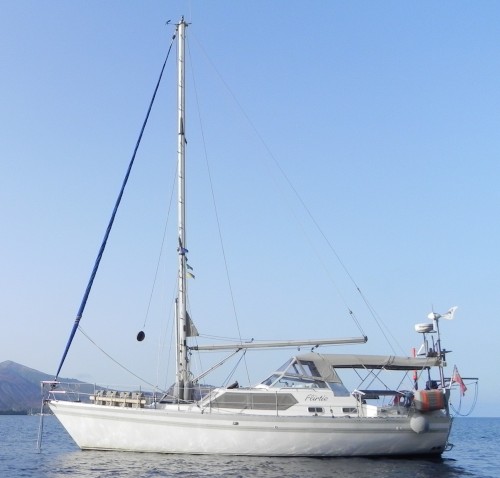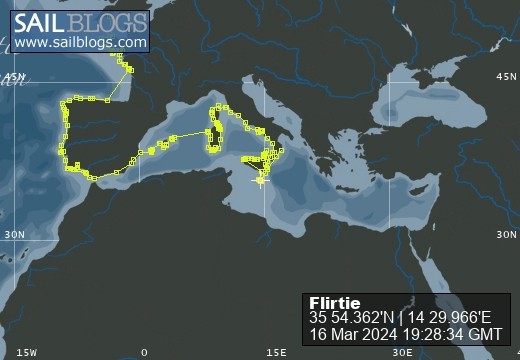stinky holding tank

holding tank re-installed & insulated...almost complete!
This season we've used our holding tank extensively whilst at anchor in all those beautiful bays and calas but unfortunately we have been plagued by the odd whiff or two.
After a little bit of research it transpires that in our case there could be a simple solution - proper ventilation!
Apparently two kinds of bacteria inhabit holding tanks: aerobic and anaerobic. I'm going to call the aerobic bacteria "good" and the anaerobic bacteria "bad". Good bacteria require oxygen to exist and reproduce and without it they die. Good bacteria break down organic matter, creating as a by-product carbon dioxide, which is odourless.
Conversely, bad bacteria thrive in a low or no-oxygen environment. The by-product they create is a variety of gases, including sulphur monoxide and sulphur dioxide which impart a pungent odour.
It is the bad bacteria that are responsible for any odours inside yachts and exiting external vents. In the case of the latter, foul odours accumulate within the tank and are expelled each time a toilet is flushed or the tank is agitated in a seaway. Because the odour-producing gas is extremely concentrated, the smell within the tank is so powerful that even a small leak can result in a very smelly cabin. Fortunately we don't have any leaks so odours inside the cabin only occur when everything is open and the wind sends it below from the vent above ;-(
Some cruisers treat the odour with a chemical - a bleach or similar cleaner or with a perfume that simply overpowers the smell. We don't like to use bleach because it isn't environmentally friendly, destroys the rubber seals in our toilet pumps and after all is only a short term solution. The bleach may succeed in cleansing the inside of the tank but because the environment is perfect for the bad bacteria they will quickly multiply and the problem starts again.
In order to provide adequate airflow, it is advised that vents should be larger than 16mm internal hose, ideally, 25mm on larger systems and if possible 38mm. Flirtie's vent is just 12.5mm (1/2") so well short of the minimum, in fact we would suggest pretty inadequate (*).
In an ideal world it is also suggested that there should be two vents plumbed to opposite sides of the boat which enables cross flow, in a direct line with as few bends and dips as possible. The theory here is great and makes good sense but unfortunately almost impossible to achieve on Flirtie given the placement of her holding tank.
...so our plan:
- Remove the holding tank
- Remove the old vent hose
- Remove the old 12.5mm through hull fitting
- Cut off the 12.5mm holding tank hosetail
- Weld a 25mm hosetail to the holding tank
- Install a 25mm through hull fitting
- Reinstall the holding tank
- Source & fit new 25mm hose connecting the two
Ok...it sounds pretty simple but like all things it proved more challenging than we anticipated.
Removing the tank was relatively straightforward, the biggest challenge being trying to keep everything clean. It will come as no surprise that we flushed the tank out first numerous times with copious amounts of water but still s*** was evident on all the pipes and hosetails. Suffice is to say it wasn't a pleasant job.
Once on the jetty the hose was put to good use once again and the tank flushed until water was running clean. It was only at this point that a closer inspection of the tank could be made. Despite being made of stainless steel part of the tank (the base and the outlet hosetail) which are permanently submerged in a caustic concoction of sea water, urine & s*** were showing some signs of corrosion. Oh dear, what have we started? Fortunately the local stainless fabricator was less phased and within a few weeks we had the tank returned suitably patched where needed and complete with two new hosetails - a replacement 38mm outlet and a new 25mm vent.

patched (top left) and two new hosetails
Removing the old vent hose and through hull skin fitting was straight forward as was installing the new larger skin fitting after we'd increased the size of the hole appropriately. We're always shocked (but very reassured) every time we work on Flirtie's hull seeing just how thickly she's laminated. I suppose it's just because she's so different to how our previous catamarans were built.
Sourcing new 25mm sanitary hose certainly proved to be a challenge with all the local chandler's failing to carry any in stock and when asked not forthcoming about ordering some either. It was starting to look like we would need to call Phil, our trusted chandler at Darthaven Marina http://www.darthaven.co.uk when we came across a Vetus agent "Riman" http://www.nauticariman.it here in Cagliari just a short bus ride away. Unfortunately Riman didn't have it in stock either but unlike the other chandler's suggested he could order it as part of his next weekly order. Having identified what we wanted from Osculati http://www.osculati.com/en/cat/MainCat.aspx (a major marine supplier here in Italy), we walked away with it the following week.
With everything now to hand it was time to put it all back together. We reinstalled the tank, connected all the hoses and gave everything a thorough test with fresh water just to make sure everything was water/vapour tight - the last thing we want is any seepages!!
Unfortunately though the real test will have to wait until next season when it will be used in earnest - fingers crossed!
* Flirtie was built in 1990 when holding tanks were virtually unheard of and at a time when the science wasn't really considered. Her holding tank was made just like her fuel and water tanks....i.e. with just a small vent/breather which allowed the tank to be filled or emptied without creating a vacuum.
This season we've used our holding tank extensively whilst at anchor in all those beautiful bays and calas but unfortunately we have been plagued by the odd whiff or two.
After a little bit of research it transpires that in our case there could be a simple solution - proper ventilation!
Apparently two kinds of bacteria inhabit holding tanks: aerobic and anaerobic. I'm going to call the aerobic bacteria "good" and the anaerobic bacteria "bad". Good bacteria require oxygen to exist and reproduce and without it they die. Good bacteria break down organic matter, creating as a by-product carbon dioxide, which is odourless.
Conversely, bad bacteria thrive in a low or no-oxygen environment. The by-product they create is a variety of gases, including sulphur monoxide and sulphur dioxide which impart a pungent odour.
It is the bad bacteria that are responsible for any odours inside yachts and exiting external vents. In the case of the latter, foul odours accumulate within the tank and are expelled each time a toilet is flushed or the tank is agitated in a seaway. Because the odour-producing gas is extremely concentrated, the smell within the tank is so powerful that even a small leak can result in a very smelly cabin. Fortunately we don't have any leaks so odours inside the cabin only occur when everything is open and the wind sends it below from the vent above ;-(
Some cruisers treat the odour with a chemical - a bleach or similar cleaner or with a perfume that simply overpowers the smell. We don't like to use bleach because it isn't environmentally friendly, destroys the rubber seals in our toilet pumps and after all is only a short term solution. The bleach may succeed in cleansing the inside of the tank but because the environment is perfect for the bad bacteria they will quickly multiply and the problem starts again.
In order to provide adequate airflow, it is advised that vents should be larger than 16mm internal hose, ideally, 25mm on larger systems and if possible 38mm. Flirtie's vent is just 12.5mm (1/2") so well short of the minimum, in fact we would suggest pretty inadequate (*).
In an ideal world it is also suggested that there should be two vents plumbed to opposite sides of the boat which enables cross flow, in a direct line with as few bends and dips as possible. The theory here is great and makes good sense but unfortunately almost impossible to achieve on Flirtie given the placement of her holding tank.
...so our plan:
- Remove the holding tank
- Remove the old vent hose
- Remove the old 12.5mm through hull fitting
- Cut off the 12.5mm holding tank hosetail
- Weld a 25mm hosetail to the holding tank
- Install a 25mm through hull fitting
- Reinstall the holding tank
- Source & fit new 25mm hose connecting the two
Ok...it sounds pretty simple but like all things it proved more challenging than we anticipated.
Removing the tank was relatively straightforward, the biggest challenge being trying to keep everything clean. It will come as no surprise that we flushed the tank out first numerous times with copious amounts of water but still s*** was evident on all the pipes and hosetails. Suffice is to say it wasn't a pleasant job.
Once on the jetty the hose was put to good use once again and the tank flushed until water was running clean. It was only at this point that a closer inspection of the tank could be made. Despite being made of stainless steel part of the tank (the base and the outlet hosetail) which are permanently submerged in a caustic concoction of sea water, urine & s*** were showing some signs of corrosion. Oh dear, what have we started? Fortunately the local stainless fabricator was less phased and within a few weeks we had the tank returned suitably patched where needed and complete with two new hosetails - a replacement 38mm outlet and a new 25mm vent.

patched (top left) and two new hosetails
Removing the old vent hose and through hull skin fitting was straight forward as was installing the new larger skin fitting after we'd increased the size of the hole appropriately. We're always shocked (but very reassured) every time we work on Flirtie's hull seeing just how thickly she's laminated. I suppose it's just because she's so different to how our previous catamarans were built.
Sourcing new 25mm sanitary hose certainly proved to be a challenge with all the local chandler's failing to carry any in stock and when asked not forthcoming about ordering some either. It was starting to look like we would need to call Phil, our trusted chandler at Darthaven Marina http://www.darthaven.co.uk when we came across a Vetus agent "Riman" http://www.nauticariman.it here in Cagliari just a short bus ride away. Unfortunately Riman didn't have it in stock either but unlike the other chandler's suggested he could order it as part of his next weekly order. Having identified what we wanted from Osculati http://www.osculati.com/en/cat/MainCat.aspx (a major marine supplier here in Italy), we walked away with it the following week.
With everything now to hand it was time to put it all back together. We reinstalled the tank, connected all the hoses and gave everything a thorough test with fresh water just to make sure everything was water/vapour tight - the last thing we want is any seepages!!
Unfortunately though the real test will have to wait until next season when it will be used in earnest - fingers crossed!
* Flirtie was built in 1990 when holding tanks were virtually unheard of and at a time when the science wasn't really considered. Her holding tank was made just like her fuel and water tanks....i.e. with just a small vent/breather which allowed the tank to be filled or emptied without creating a vacuum.




Comments